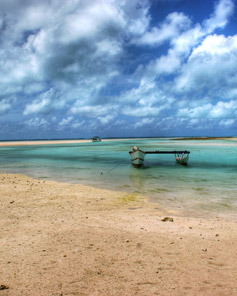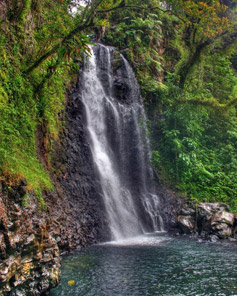Glossary of terms
 Area: A part or subdivision of a supply and distribution system that is of an unspecified size.
Area: A part or subdivision of a supply and distribution system that is of an unspecified size.Communication pipe: A part of a service pipe running from a main to, and including, a stop cock. It runs as closely as is reasonably practicable to the boundary of the street in which the main is laid.
Customer: A person, business or other operation supplied with water by a water supply utility.
Consumption: A volume of water taken from a water supply main into a customer's installation.
Demand: The volume of water placed into a supply and distribution system to satisfy the requirements of customers. It includes leakage and other waste which may be incurred in the process.
Distribution main: A pipe laid by the water supply utility giving a general supply of water, as distinct from a supply to individual customers. It includes any apparatus used in connection with the pipe.
District: An area of a supply and distribution system (but usually of a distribution system) that is specifically defined, e.g. by the closure of valves. The quantities of water entering and leaving the area can be metered permanently.
District meter: See meter - district.
Inspection: A physical investigation to locate leaks by using sounding and metering methods, eg step tests.
Intrinsic leakage level: The volume of water lost from a metered area where no active leakage control (ALC) program is in place. It is the same volume the system will return to if ALC demand management strategies cease to take place.
Leak detection: The process of detecting and locating leaks.
Leakage: Waste which either leaks or escapes accidentally.
Meter – combination or dual flow: A meter installation consisting of two or more devices, usually of different types used preferentially, such that the best characteristic of each device is used at that flow range at which it is most accurate.
Meter – district: A device that measures the quantity of water moving into or leaving a district.
Meter – source: A device that measures the quantity of water entering a supply and distribution system from source works.
Meter – waste: A device that measures and records the night -time range of flow rates which pass into a waste district.
 Metered consumption: The quantity of water registered on customers' meters and occurring on customers' properties. It includes waste, leakage and meter error.
Metered consumption: The quantity of water registered on customers' meters and occurring on customers' properties. It includes waste, leakage and meter error.Minimum night flow: The minimum amount of water flowing into an area during the night.
Natural rate of rise: The theory that states that the rate of losses will continue to rise when no active leakage control takes place.
Net night flow: The difference between minimum night flow and metered consumption.
Night line: See minimum night flow.
Non-revenue water: Water which does not generate revenue for the water utility. This is because of a lack of metering, inaccurate metering, other apparent losses or because it is metered but not billed.
Pipe locator: A portable electrical or electronic instrument specifically designed for use in the field to assist in locating buried pipes.
Pressure control: The reduction of hydraulic pressure to, or the maintenance of pressure at, a predetermined desired range of pressures within defined zones.
Property: Building premises or structure that is occupied by a customer and separately identified for billing purposes.
Section: A subdivision or 'step' in a Waste District.
Service pipe: A portion of any pipe that supplies water from a main to any premises. It is subject to water pressure from that main, or would be, but for the closing of some tap.
Service reservoir: A water-retaining structure hydraulically linked into a supply and distribution system. It provides storage capacity to meet diurnal variations in demand and provides reserve supplies of water for emergency purposes.
Sounding – direct: A method of searching for leaks. Trained inspectors listen for the characteristic noise of escaping water using either a stethoscope or electronic leak detector that is applied directly on to a main, valve or stopcock. It may be carried out at night when both ambient noise and consumption are at a minimum.
Sounding – indirect: A method of searching for leaks, similar to direct sounding. Here the stethoscope or electronic leak detector is in contact with the ground surface. The method is dependent upon sound being transmitted through soils, backfill, road material etc.
Sounding – stop tap, stopcock: See sounding - direct. Particularly used to detect leakage from a customer's installations.
Sounding – surface: See sounding – indirect.
Sounding – valve and hydrant: A form of direct sounding applied initially to the water supply utility's valves and hydrants.
Step tests: A method of enhancing the effectiveness of waste or district metering. This is done through the closure of successive valves to reduce the size of the waste district temporarily whilst simultaneous measures ofrate of flow are being made.
Supply: The amount of water made available to satisfy demand.
Supply and distribution system: An arrangement of apparatus, installations and works operated by a water supply undertaking between the point of abstraction from a source and the customer's installation.
Supply pipe: The portion of any service pipe that is not a communication pipe.
System: An arrangement of apparatus, installations and works operated by the water supply utility.
Trunk main: A main with few branches constructed and used for conveying relatively large volumes of water.
Utility: See water supply utility.
Unmetered consumption: Volume of water taken by customers other than through metered connections.
Valve inspections: See step tests
Waste: Water which, having been obtained from a source and put into a water supply and distribution system and customers' installations, leaks, or is allowed to escape or is taken for no useful purpose.
Waste district: An area normally smaller than a district, the inflow of which is capable of being measured through a waste meter (often a portable meter). Tests can be carried out tracing leakage to relatively small sections. The difference between a waste district and DMA is that waste districts are only zoned off at night-time. Otherwise they would be known as a DMA. The size of a waste district is traditionally less than 500 properties.
Waste inspector: An employee or other person skilled in the practical work involved in identifying causes of waste and, in particular, locating leakage.
Waste meter: See meter - waste.
Water accounting: A method for accounting for all water in a system.
Water supply utility: A statutory organisation with the responsibility of providing a public water supply.
Zone: An area of a supply and/or distribution system which is or can be specifically defined by the closure of valves or the end of a reticulation system.
References: Queensland Environmental Protection Agency and Wide Bay Water Corporation (2004): Managing and Reducing Losses from Water Distribution Systems. A series of 10 manuals.

















